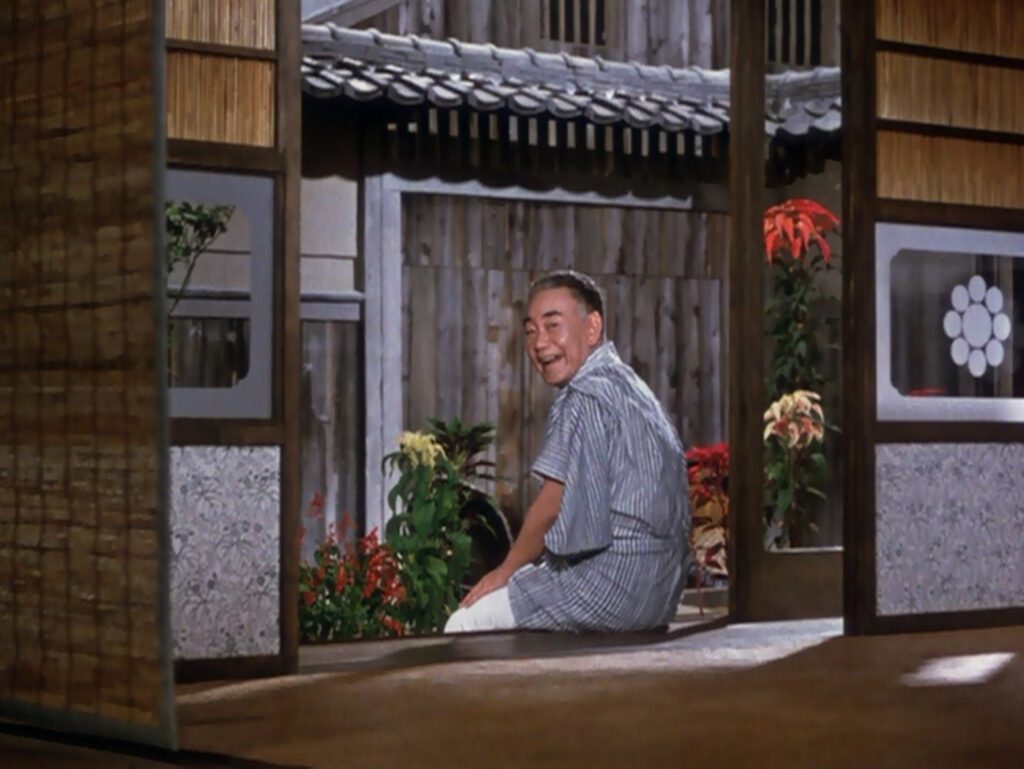
The End of Summer
1961, directed by Yasujiro Ozu
There’s a strange cut in the last four minutes of The End of Summer that could easily escape notice. Viewers who catch it will probably wonder for a moment what happened, then forget about it. The cut is from Noriko, framed against the sky in her black mourning costume, to a nearly identical shot of her elder sister Akiko, framed the same way in the same uniform. This cut effectively sutures the two women as boldly as Ingmar Bergman sutures two women’s faces together in the most famous shot of Persona, five years later. In Persona at least there’s an obvious artistic intent. Here the viewer has no time to examine the suture, and anyone might wonder whether it’s a mistake.
It’s not a mistake. In fact the cut gives emotional weight to the movie’s argument, helping us to feel the reality of a radical claim about the passage of time.
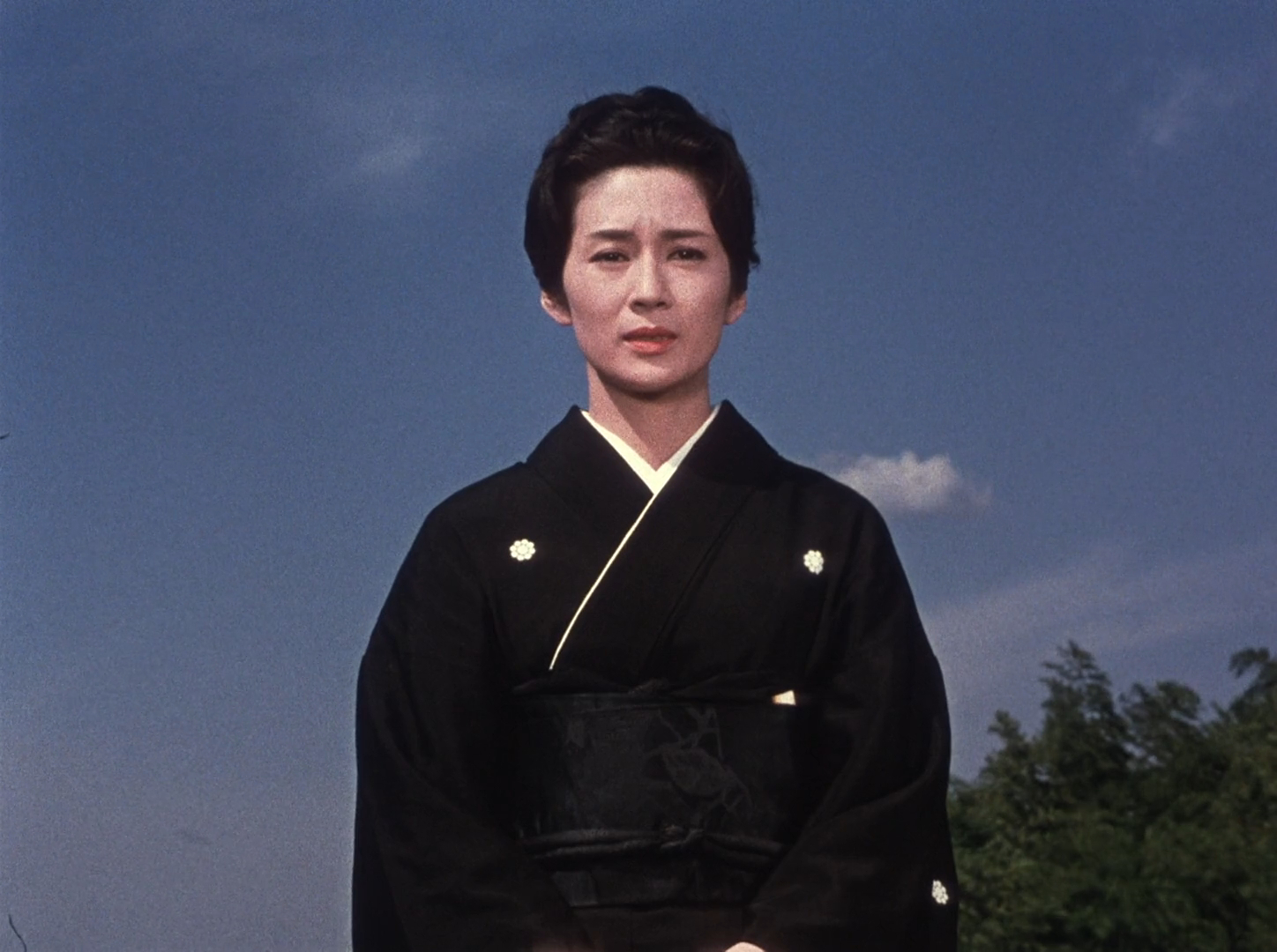
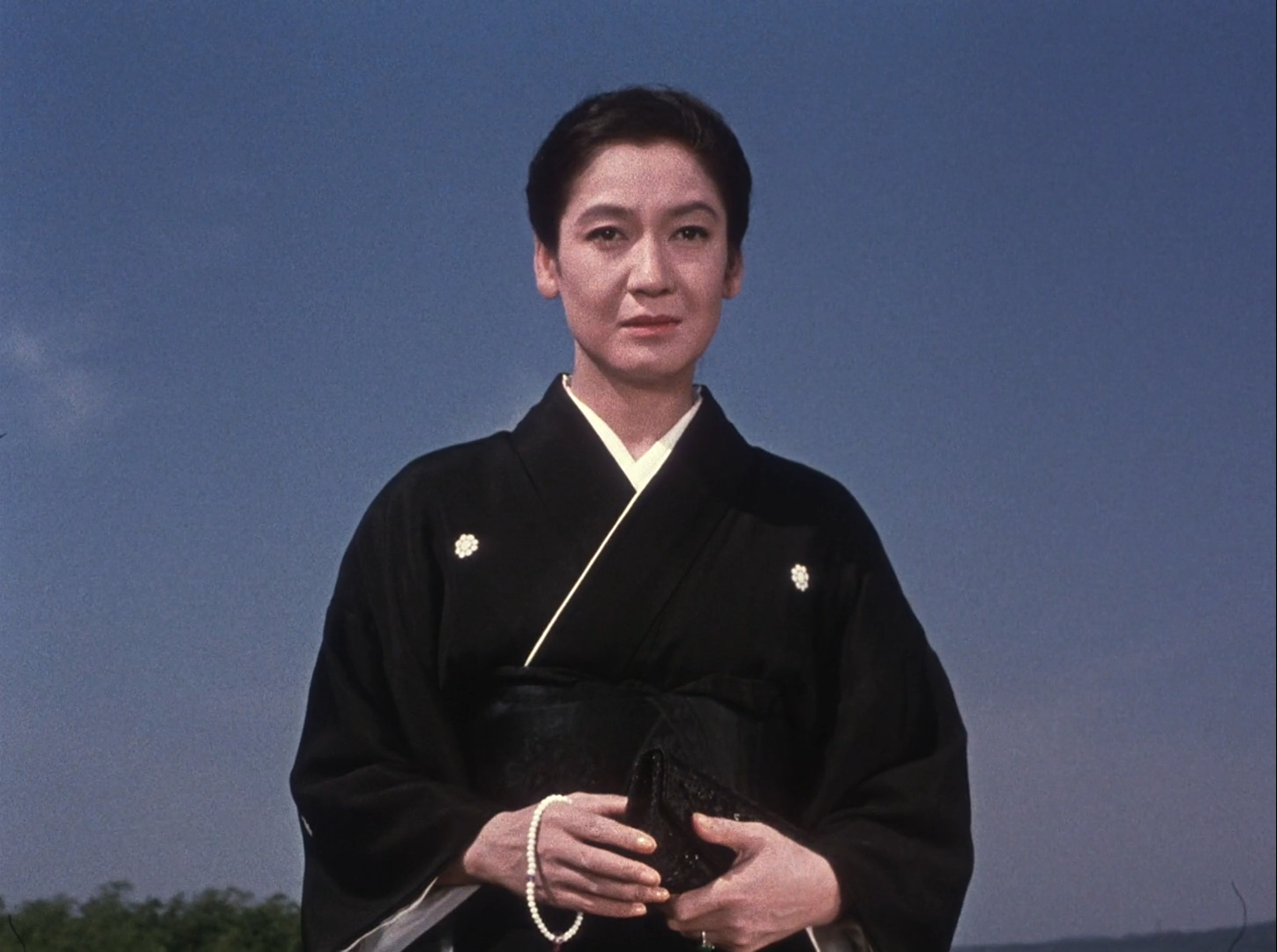
The End of Summer opens with the neon lights of Osaka, giving prominence to the English sign for a “New Japan” hotel. No one can doubt that the movie itself is a portrait of a new Japan, with all its signs of modernization and globalization, often contrasted with signs of traditional Japanese culture. In the first scene Akiko walks into a chic modern bar wearing traditional clothing. The opening is distinctly modern with its city lights and nightlife, and the ending at the cremation ceremony is distinctly traditional. The architecture of the Kohayagawa family home and old Kyoto contrasts with modern office buildings and Akiko’s apartment. We’re constantly reminded that the family’s traditional sake brewery must yield to modern corporate brewing. Tsune’s daughter Yuriko is conspicuously modern, dressing stylishly and dating American men. Noriko is pressed to choose between a traditional arranged marriage and a modern love match.
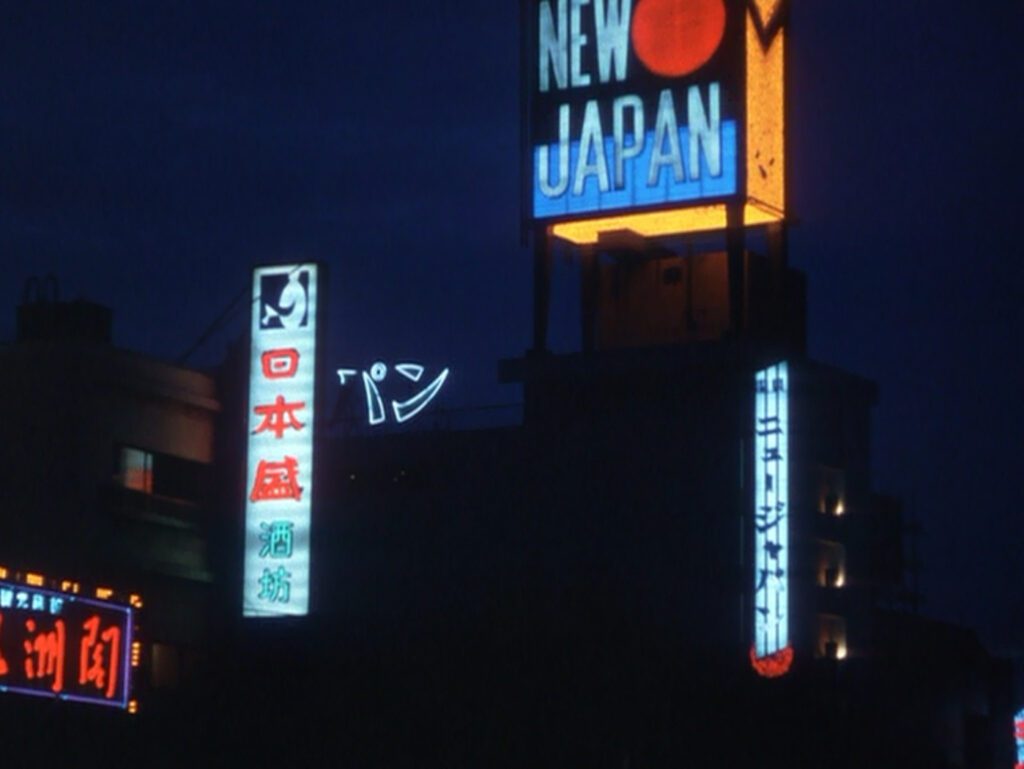
The biggest event in The End of Summer is the death of the family’s patriarch, Manbei Kohayagawa. His death represents the end of the old order… the family business will be sold, and the extended family will no longer live together. Manbei dies of a heart attack while visiting his old mistress in Kyoto, but he is symbolically killed off by the youngest generation when his grandson fires imaginary pistols at him as he leaves home for the last time. The boy might also have killed him literally, wearing him out with sports and games.
Ozu is not taking a wistful view of the new order in Japan, nor is he looking nostalgically at the nation’s eroding traditions. His films recognize the difficulty of change, but they also recognize its benefits. If his precise attitude to change is difficult to pin down, that’s only because it’s not one of the usual familiar attitudes that define liberalism or conservatism. In short, Ozu’s films – and especially The End of Summer – argue for an innate harmony between old and new.
Akiko and Noriko are sisters, yet they personify tradition and modernity respectively, without exaggerating their ages or dispositions. Their age gap is unspecified, but the actresses are 14 years apart, and there’s a running joke that Akiko must pay Noriko 100 yen each time she calls herself “old” – perpetually reminding us of what she’s not supposed to utter. She’s already a widow, yet Noriko has barely entered adulthood. Akiko always dresses traditionally, while Noriko always wears modern clothes except at the cremation. It’s remarkable that old and new Japan are represented in the same generation, and they’re about as close as any two characters can be. Like many intimate pairs in Ozu’s films, their movements are synchronized in a kind of slow dance to emphasize the harmony between them. Their footsteps match, they crouch down and stand up simultaneously, and they get along without the slightest disturbance. Together they’re a metaphor for the harmony Ozu sees between tradition and modernity, and when the movie cuts between them so invisibly near the end, it drives home the feeling that the two women are fundamentally similar.
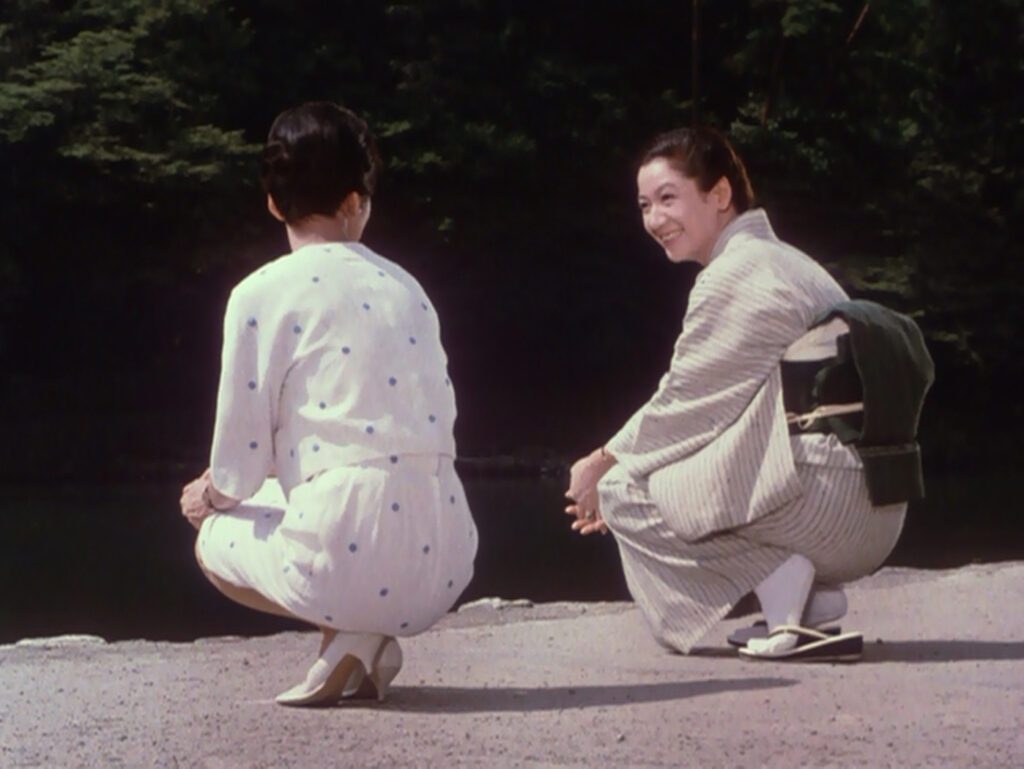
The old man, Manbei, is the apparent protagonist, but Akiko and Noriko are introduced earlier and get the privilege of closing the film. At the cremation supper Fumiko laments that Manbei “was the only thing keeping the Kohayagawas afloat,” but right after she says that, as if gently refuting her, the movie cuts outside to Akiko and Noriko. In their own way these sisters have been keeping the family afloat, just as the harmonious pairing of tradition and modernity will keep Japan afloat even after the old order dissolves.
Right after the cut that sutures Akiko and Noriko, the film returns to a cameo of Ozu’s regular leading man Chishu Ryu as a farmer washing his tools near the crematorium. Seeing smoke rising from the chimney, the farmer says to his wife, “No matter how many die, new lives will be born to take their place.” “You’re right,” says his wife, “it’s the cycle of life.” Looking at time as a cycle is one way to reconcile the pros and cons of the old way of life giving way to the new. We all know intuitively, at least if we reflect on it, that the process of modernization is part of an unending process of change that recurs in every generation.
Reinforcing this cyclical view of time, The End of Summer is full of echoes and parallels, reminding us that both life and history are full of repetitions. The old man’s hide and seek game with his grandson mirrors his cat and mouse chase through old Kyoto with his employee Roku. The wake by the crematorium at the end matches the outing to Arashiyama in the middle, where the family had also gathered at a traditional restaurant surrounded by nature. The family stands up in surprise when Manbei recovers, then again when the smoke rises at his cremation. Twice Yuriko heads out with her American boyfriends, each time quickly doubling back to salute Manbei. (Her dates are George and Harry, like the first U.S. president and the one who ended World War II.) There are two scenes at the bar with Mr. Isomura, and two daughters being encouraged to marry.
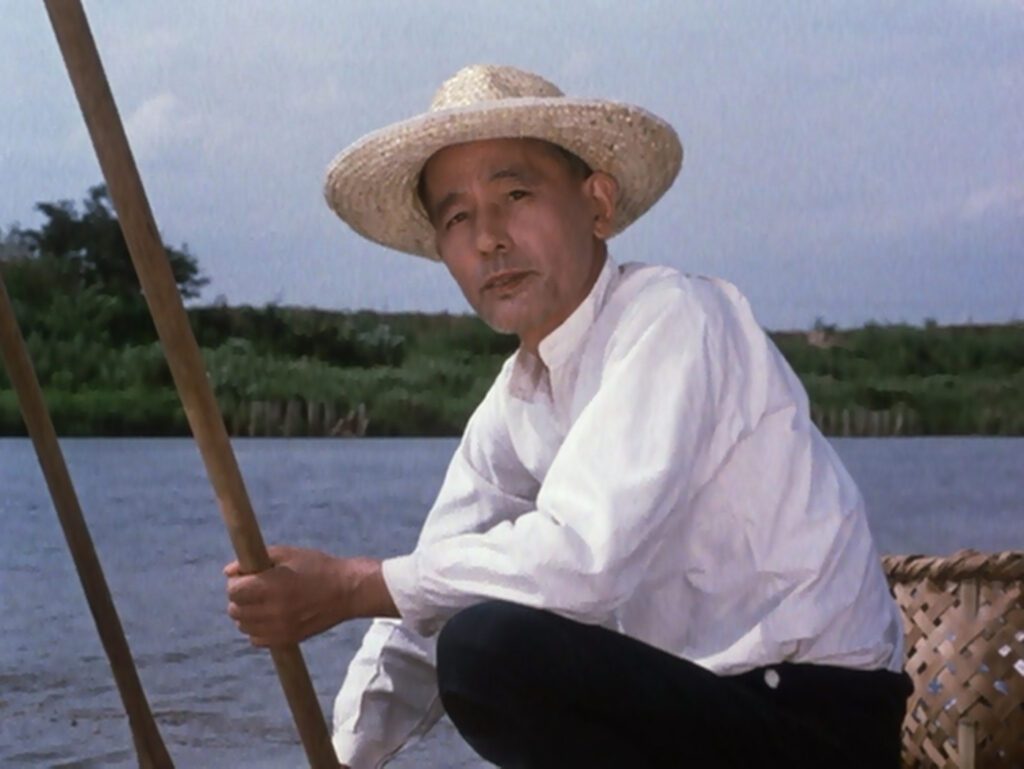
Describing a “cycle of life” however can sound banal. It’s an old and familiar way of reframing linear time, and Western viewers may be tempted to exoticize it as an “Eastern” view of time. Ozu’s films almost always introduce both linear and cyclical time, presenting the difference as a paradox to be wondered at. The End of Summer, for instance, is full of clocks, which measure linear time. Instead of comforting us with platitudes about unending cycles of renewal, Ozu’s movies aim for the broadest possible perspective on time. He is neither shaking his head sentimentally over the loss of a golden past nor celebrating its replacement by some glorious future. Nor, for that matter, is he taking an insipidly stoic view that whatever happens is inevitable. Rather, The End of Summer asserts a balance between old and new, overturning the convention that historical change must be a series of rebellions or revolutions. History may be turbulent, but it needn’t be so unbearably disruptive if people understood the potential harmony between old and new that Akiko and Noriko personify.
Just as the movie sutures the two sisters in that cut near the end, it also sutures three of Ozu’s most acclaimed films, synthesizing the plots of his “Noriko trilogy”. There’s a father marrying off his daughter (Late Spring), a daughter moving north to join the man of her choice (Early Summer), and the death of a parent (Tokyo Story). Baseball and Coca-Cola references are recycled from Late Spring and Early Summer, and in place of the suggestion that a young woman’s fiancé looks like Gary Cooper, Yumiko actually dates Americans. Whereas Kyoto was like a museum of the past in Late Spring, and Osaka was a train stopover representing the encroachment of linear time in Tokyo Story, both cities in The End of Summer are real everyday locations, yet they preserve their previous meanings. Manbei revisits his past in Kyoto, and Osaka represents time moving forward. The End of Summer rephrases the two key lines that cap off Tokyo Story so memorably – instead of Kyoko’s line “Isn’t life disappointing?” Tsune says “Life is so fragile,” and instead of Shukichi saying “If only I had known she would die, I would have been kinder to her,” Yumiko says that if only she knew her father would die, she would have gotten him to buy her a mink stole. These differences reveal a movie that’s not exactly more jaded than the predeceding trilogy, but which purposefully dampens the emotional force of those plots. That doubtless explains why The End of Summer has never been as popular as Ozu’s most acclaimed works, but by deflating the emotional effect of its story it opens greater space for understanding and wonder.
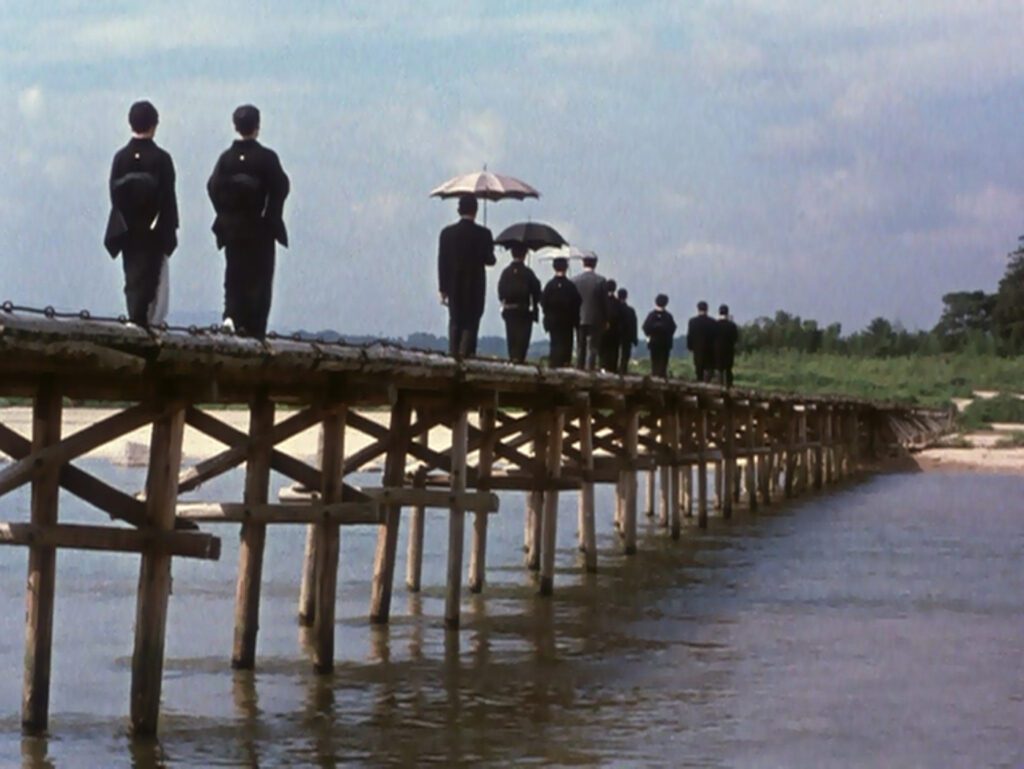
Instead of the exquisite melancholy at the endings of the Noriko films, The End of Summer aims for a broader vision, enabling us to see life and time from multiple angles at once. It’s full of ironies. Manbei represents the family’s and nation’s dying traditions, yet he’s the most youthful character, always sneaking around and getting into mischief. In a movie about change, it’s ironic that the camera always remains fixed. Likewise, it’s ironic that a story about Japan’s modernization begins with neon lights and a jazz bar, and it ends with farmers, rice fields, an old wooden bridge, and a teahouse where everyone wears traditional costumes. The greatest irony though is at the very end. As the mourners walk in stately procession across the long bridge outside the crematorium, Akiko and Noriko linger behind to discuss their futures. In the last line, Akiko – the embodiment of tradition – says, “Let’s catch up. We shouldn’t be too late.” If the past itself can say such a thing to the present, then we needn’t cling to the past as if it wants to remain fixed forever.
CONNECTIONS:
Late Spring – Story of a father marrying off his daughter; synthesis of tradition and modernity; baseball allusion; Coca-Cola advertisements; idea of dating a foreigner; use of Kyoto to represent the past
Early Summer – Daughter who resists her family’s arranged marriage and will move north with the man of her choice
Tokyo Story – Story about parents; two lines near the end restated; Setsuko Hara plays a widow; reach for the ineffable at the end
Equinox Flower – Electric advertisement or logo that comments implicitly on the story
Good Morning – Cut near the end between identically framed shots (clocks/sisters), from the modern/younger to the antique/older
An Autumn Afternoon – Idea of modernity being “late”; smoke rising near the end at a moment of loss
Persona – Two women who are close to each other are sutured in a cut or split-screen that emphasizes their similarity
Weekend – Argument against the Hegelian dialectic